MilliBee with a haircut?
12345678
... 17
12345678
... 17
|
|
Result!
Well done. Perseverance pays off. Tim. On 10 Jul 2012, at 22:03, adminHBBR [via UK HBBR Forum] wrote: > Ta Da! |
|
|
This post was updated on .
In reply to this post by Paul H (admin)
Hi Paul,
You may want something to help centralise boat on trailer as you havnt got much lee way with the position of your rollers/hull. I'm just thinking of conteracting cross wind or tide when retrieving boat. The "break back" concept on a rigid trailer can work well although can look alarming to onlookers, I used to chock trailer so as trailer could rear up as boat was winched into its position on trailer before connecting to car, so I remember, Hope it helps Matthew |
|
|
I had the problem of the wind blowing the boat out of line with the trailer with a small trailer-sailer I owned years ago. As a fix I clamped two alloy scaffold poles to either side of the trailer, pointing upwards. I slid bits of rubber radiator hose over them to protect the hull, and they then kept the boat from drifting sideways until it was on the trailer. In my case, the trailer had to be submerged to recover the boat, so these poles acted as above water guides to show where the trailer was, too.
I've seen shorter cranked clamp on poles like this on the back end of some trailers, probably fitted to do the same thing. |
|
|
In reply to this post by Paul H (admin)
Hurrah and congratulations!! Tony From: adminHBBR [via UK HBBR Forum] [mailto:[hidden email]] Ta Da! |
|
|
In reply to this post by Paul H (admin)
Here is a quick shot of one centreboard blank, compared to a Mirror dagger-board and one metre ruler for reference.
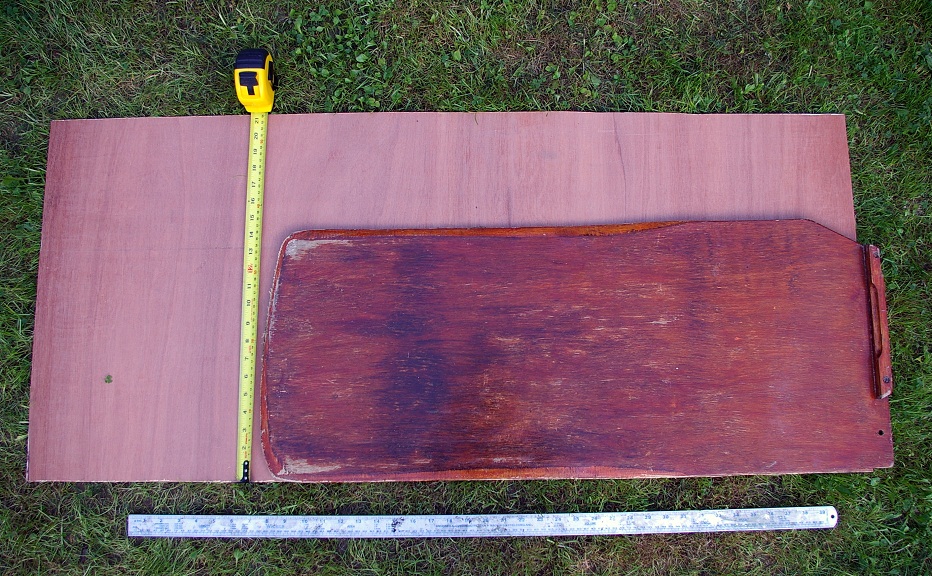 It's about 21in high and 4ft long (53 x 122cm) - the Enterprise centreboard is about 110 x 40 cm. There will be tapering towards the pivot but this is a good starting size. The case sides are about 5in longer and 1in taller; the two centreboard blanks and two case sides nested nicely into one sheet of 9mm ply with minimal wastage. I have some spare 6mm to laminate a 9+9+6 board. The generous height is the external distance from keel to cockpit seats, allowing for a flush bridge deck on top of the case. The next challenging step is some micro-surgery within the hog and cockpit floor, which is packed full of polystyrene, making a slot with minimal damage.... -Paul |
|
|
This post was updated on .
Cutting a 2in slot for the centreboard case went well, using a jigsaw and a Bosch multi-tool edge cutter. I stopped just in front of a joist running underneath the cockpit floor which was screwed to the bilge cases.
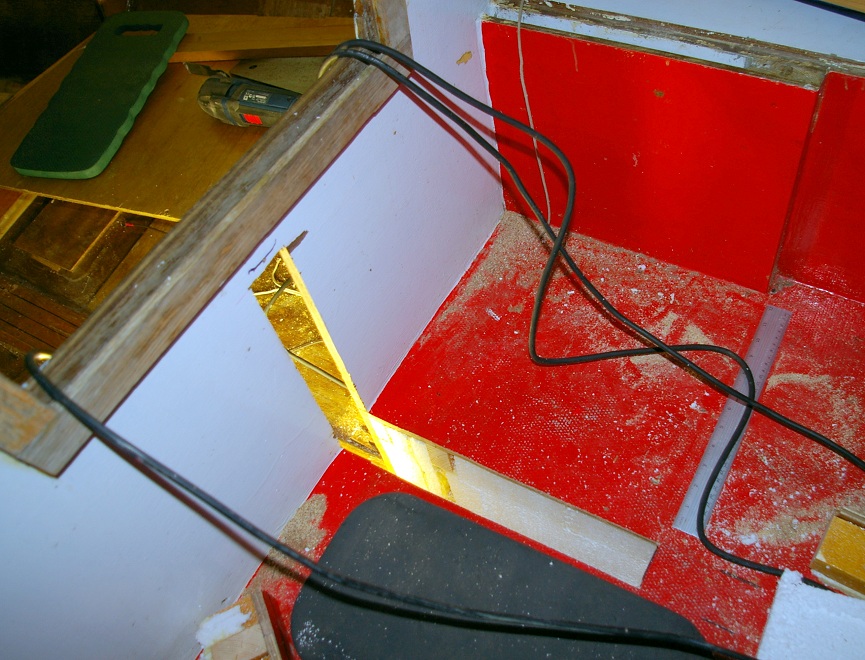 A length of scrap wood gives an idea of the (maximum) case length in the cabin - it won't interfere with sleeping at all, especially if tapered towards the pivot (the floorboards and port bunk have been removed): 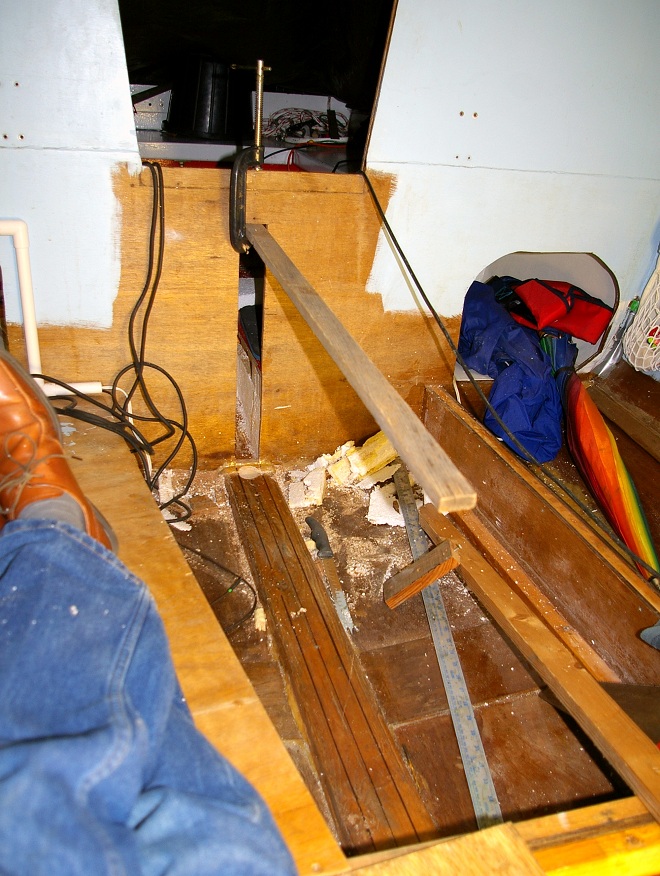 As John P suggested its easy to add a removable table top, big enough for the Leisure Folio charts: 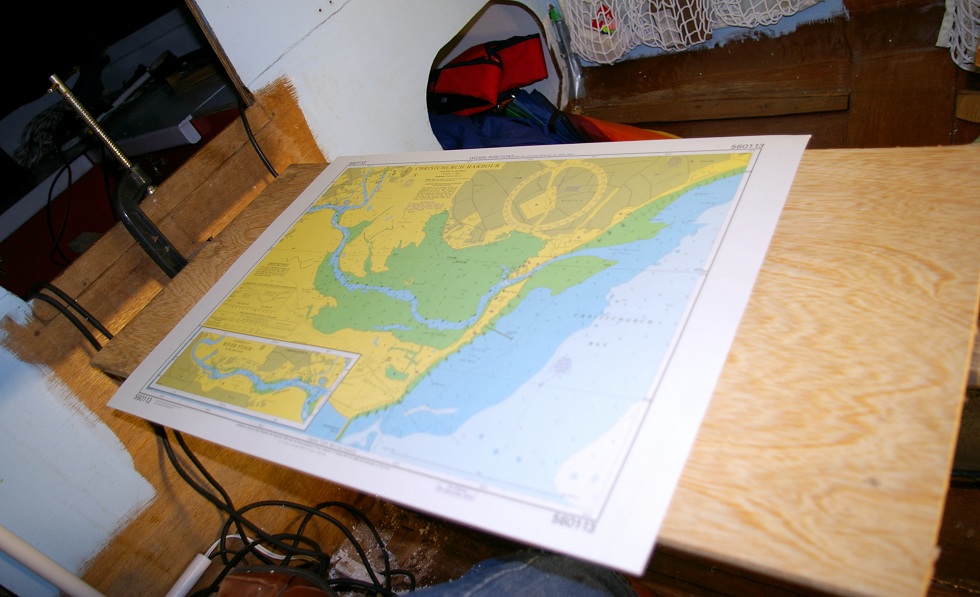 -Paul |
|
|
Paul, I noticed that your chart shows Christchurch harbour, my favourite little place in the whole world, many childhood (and grown-up) holidays there and my first sailing experience.
Your centreboard conversion is very brave and looking good. |
|
|
Thanks Alan - maybe you could organise a meet in the harbour one day?
We certainly need an expert on the tides....as a kid I was fascinated by the ferry near the harbour mouth motoring with a leeway of 45 degrees to fight the tide! -Paul |
|
|
Paul, I windsurfed a lot in the 80's in Christchurch harbour. Know the tides well there, and as you say you do need to keep away from the run unless planning to sail outside. Cannot think of a camp site on the harbour edge though. We did have a nice meet early on in the life of the HBBR at Keyhaven. There is a camp site at the end of the cycle track into Lymington, but again not actually at the harbour side. Boats could be left in the boat yard. Perhaps both are best for a single winter day meet? Christchurch River is also very nice to explore as well.
Brian |
|
|
I want to move to weekend meets, to make the most of travelling over 100 miles. |
|
|
On 6 Sep 2012 at 5:12, adminHBBR [via UK HBBR Forum] wrote:
> > > > BrianP wrote > > > > Perhaps both are best for a single winter day meet? > > > > I want to move to weekend meets, to make the most of travelling over > 100 miles. > Christchurch harbour is too small to contain a weekend meet. It could, however, be a good start/destination for a weekend including the Solent or Poole. -- Hoping for calm nights Alastair Law, Yeovil, England. <http://www.little.jim.freeuk.com> |
|
|
In reply to this post by Paul H (admin)
"Cutting a 2in slot for the centreboard case went well, using a jigsaw and a Bosch multi-tool edge cutter. I stopped just in front of a joist running underneath the cockpit floor which was screwed to the bilge cases."
That must have been an unnerving few minutes Paulie Brave lad! Looks really good CW |
|
|
In reply to this post by Paul H (admin)
Here is a mockup of the bridge deck, 12in wide, and the centreboard case protruding 18in into the cockpit. That leaves about 30in inside the cabin. I'm not so bothered about space in the cabin, what I don't want is the crew tripping over the case when tacking.
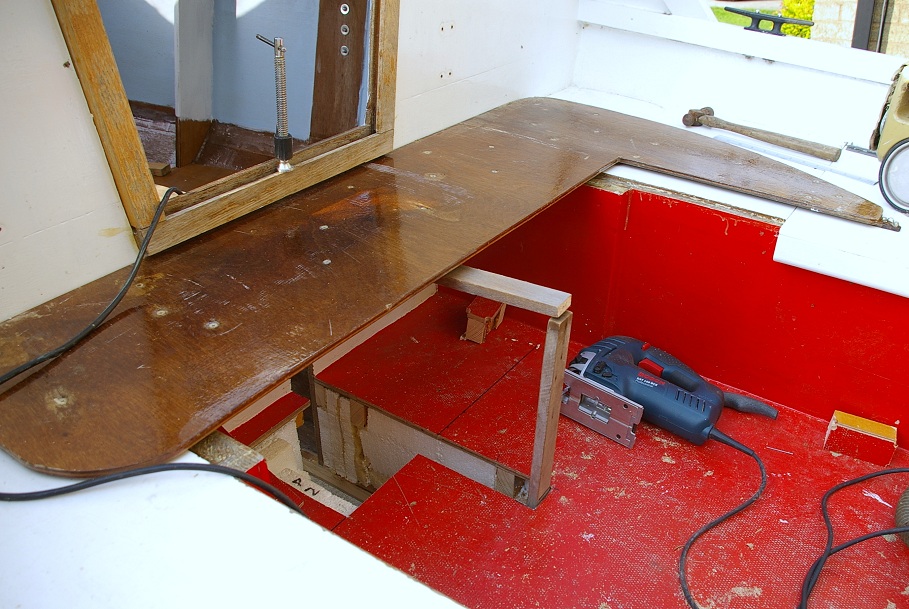 I have to cut access panels to give essential access to epoxy the case to the hog - they will be glued back in place as the last step. She used to have an Ent mast and sails which combined with the old bilge boards created weather helm (more than you get on a Mirror). I'll be moving to a gunter 2 part mast and the bowsprit allows all manner of jibs/genoas to be used...so Cee Dubbs and myself think there are plenty of options to tune the rig to balance the boat. Plus the original skeg design, that I didn't fit, could shift the centre of lateral resistance backwards up to 18ins. I'm roughly following the Enterprise centreboard - just under 4ft with a pivot 45cm behind the mast....the net result is a centre of lateral resistance under the sail centre of effort if the board is fully dropped to a vertical position. The new pivot will be 10in behind the bilge case pivots and with the new board 4in further into the cockpit the weather helm should be a bit better. 9+9 laminated ply for the board seems strong, it takes my weight and when glassed should be tough enough. Comments are welcome, especially with regard to the case protrusion into the cockpit. There is scope for moving it a few more inches back but the "perfect" position for the centreboard is probably impossible to predict. -Paul |
|
|
If you make that ply panel on top into a permanent boxed in bridge deck, it will give useful buoyancy, and possibly storage space. If you make it triangular from the corner of the bulkhead to the extremity of the centre board case, it will not impede much on cockpit sole length when stowing long things. This will prevent crew tripping, but may be a "bridge too far"?
|
|
|
In reply to this post by Paul H (admin)
Excellent work!
Firstly, train your crew in your Mirror. After a spell in the confined space of a Mirror cockpit with that low boom, kicker, dagger board etc. Millibee's cockpit will seem enormous. I would box in the bridge deck, and probably use one side for storing the galley equipment, and the other for a cooler. You could always make one side accessible from inside the cabin. What shape is your centre board? If it had a curved or slanting trailing edge, the six inches protruding beyond the bridge deck could have that sharp corner moulded to fit the board. Make the case to fit the board. Go on my son! |
|
|
Graham,
The cooler and galley idea is interesting, but maybe its better to move some heavy items forward from the rear locker...things you need in the cockpit like tools, mooring pegs, ground tackle. Also it's an easy place to fit a bilge pump that empties into the case. High-tech electric with computerised speed control plus wireless remote control of course 
I did think about a slanting trailing edge - the area is the same but does it affect performance? Momist - I think there is enough length when boxed in... certainly not a bridge too far. -Paul |
|
|
Ha, you mean a bucket. |
|
|
In reply to this post by Paul H (admin)
A little heap of design criteria for consideration:
If you make the bridge deck as wide (fore and aft) as you can bear, then box in the whole thing with access from the cabin only, it reduces the amount of water she would take in the event of the cockpit being swamped. Don't worry about the crew's legs - how often have you had anyone else on board, compared with the amount of time you have been singlehanding? Also the case can not only be extended with less impingement on the foot well, if the aft edge slopes from the back edge of the bridgedeck down and backwards; this also discourages the lower inner aft corner from acting as a scoop, with all the attendant drag and slopping water up over the rim. Having an open top and a removable cap rather than being closed, means that us chaps don't need the bucket When we personally need to pump ship CW |
|
|
CW,
Ok - I'll prototype the bridge deck with the original 14in of ply (that launched Illusion*) which spans the old bilge cases. Does slanting the rear edge affect performance in any way? The effect will be a "pointy" profile underwater, slightly deeper below the waterline. Paul Fisher used a 1 in 4 slant - about right? -Paul *After cutting the prototype bridge deck out of a sheet of 9mm bought especially for the purpose......I decided to build a boat with the remaining ply! |
|
|
In reply to this post by Paul H (admin)
Looking at all the options to adjust the cabin I realised one of the easy and most beneficial changes is to shorten the cabin, by about one foot:
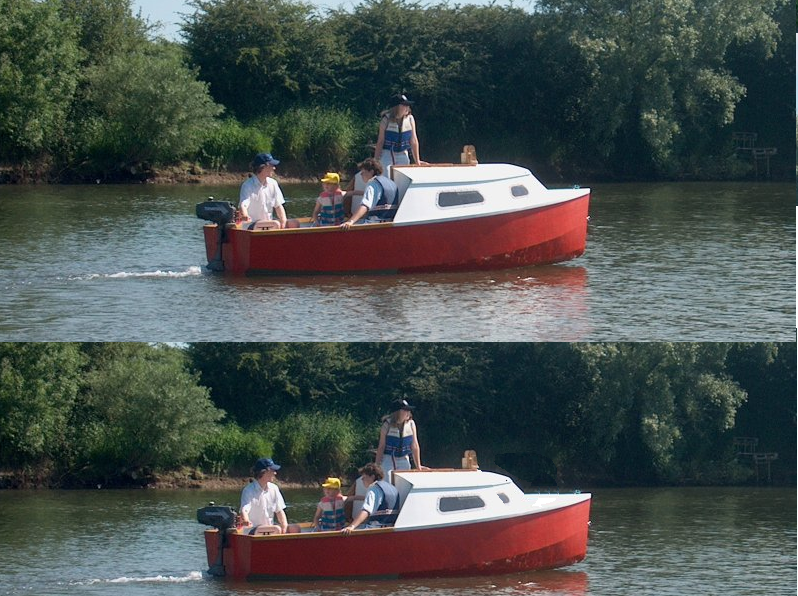 It makes quite a difference yes? There will be less windage and more space for the jib/genoa/bowsprit. -Paul |
«
Return to General Discussion
|
1 view|%1 views
| Free forum by Nabble | Edit this page |

